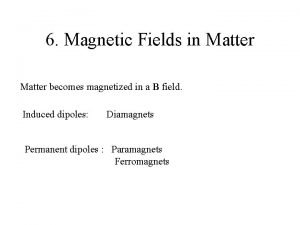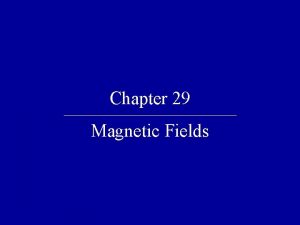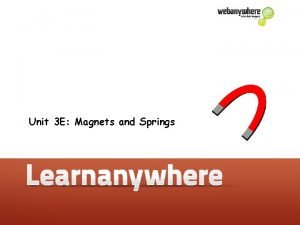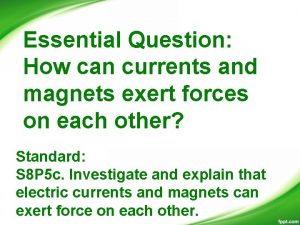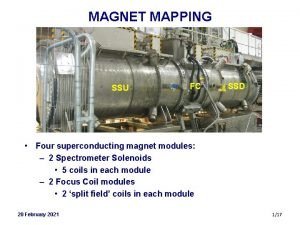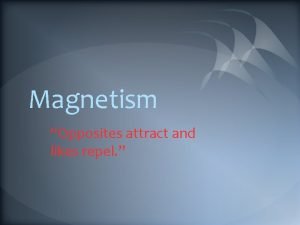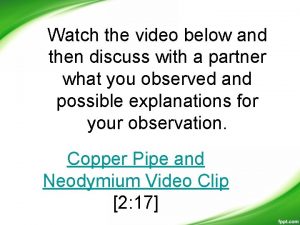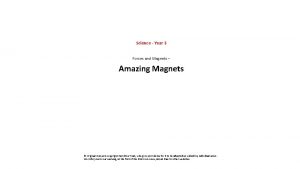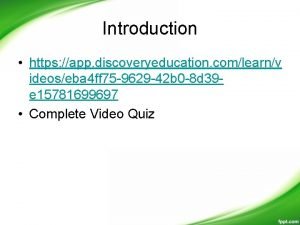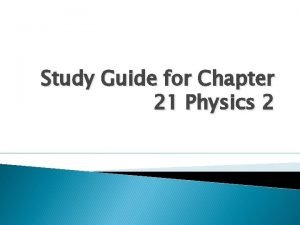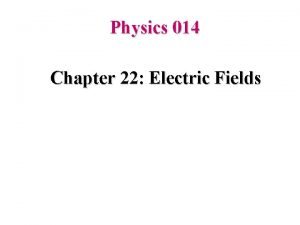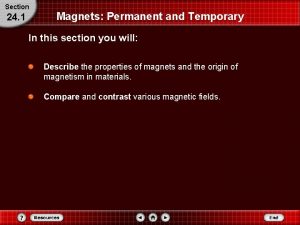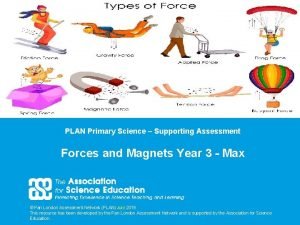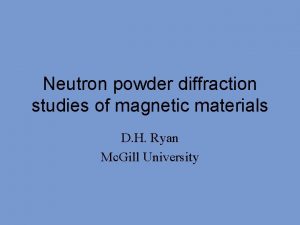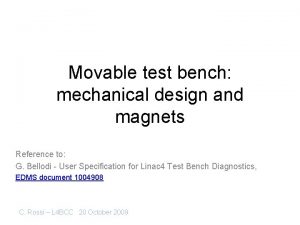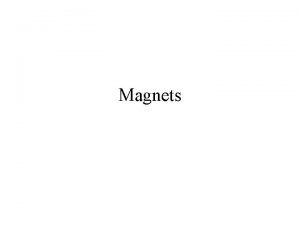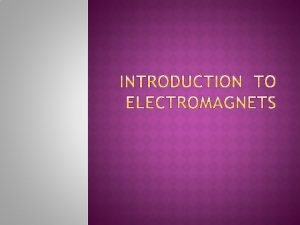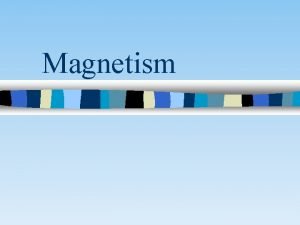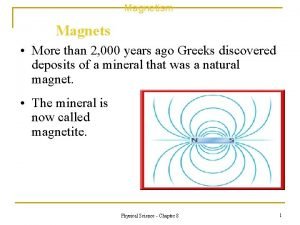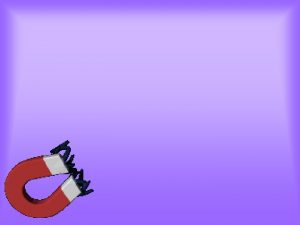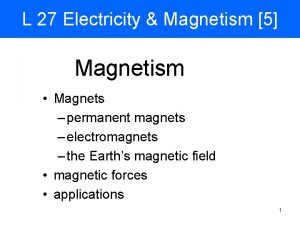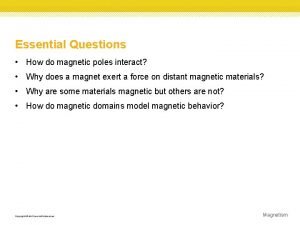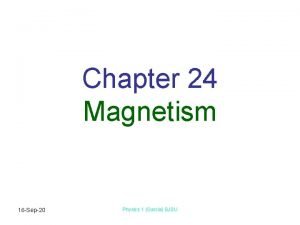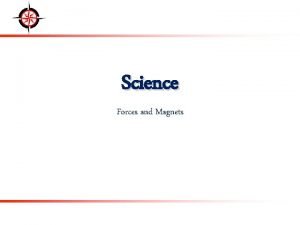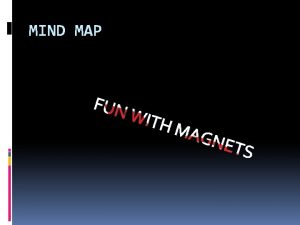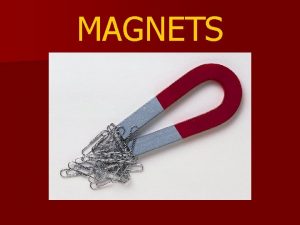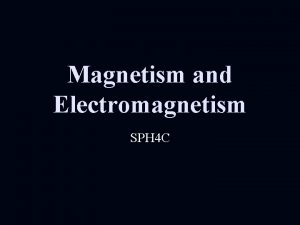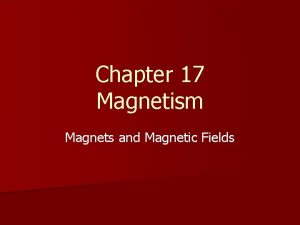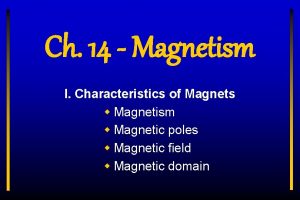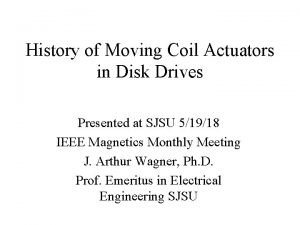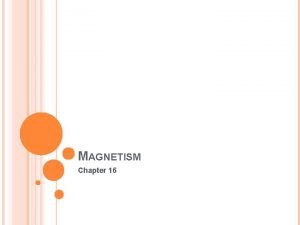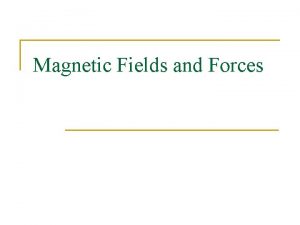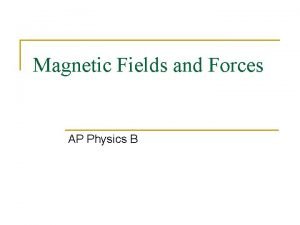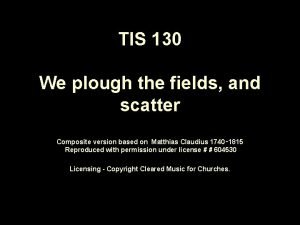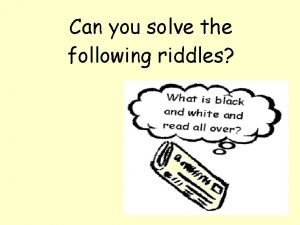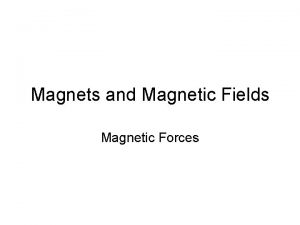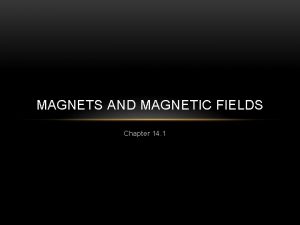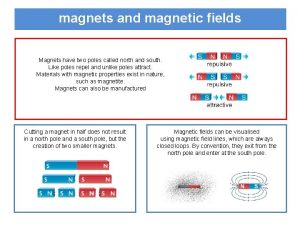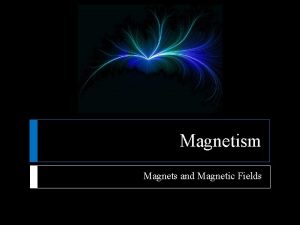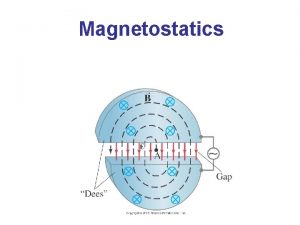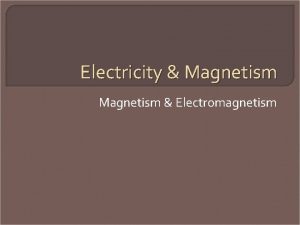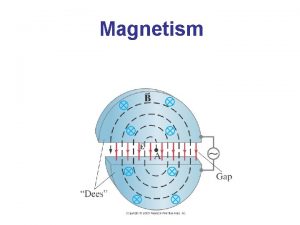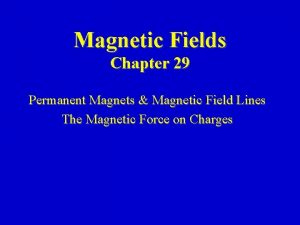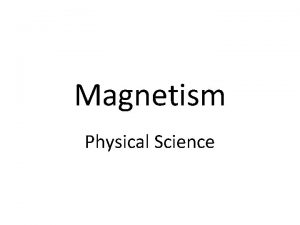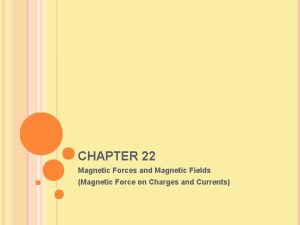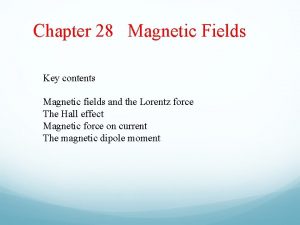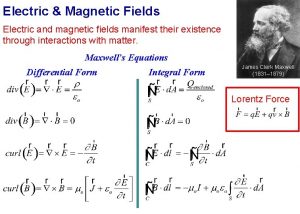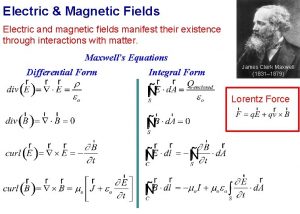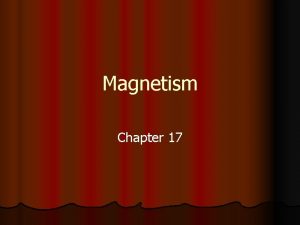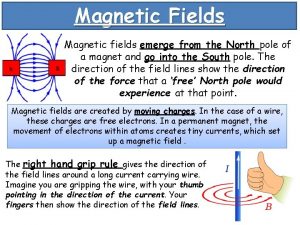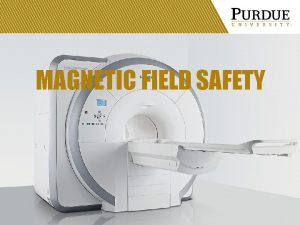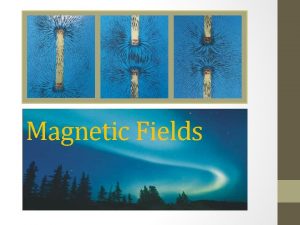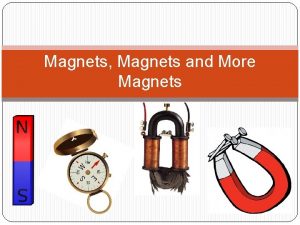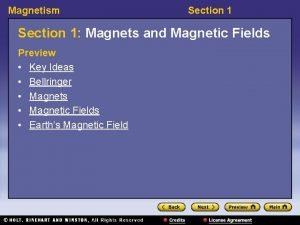Chapter 19 Section 1 Magnets and Magnetic Fields



























































- Slides: 59

Chapter 19 Section 1 Magnets and Magnetic Fields Magnets • Magnetism =due to moving electrical charges. • Magnets have two distinct poles called the north pole and the south pole. • Like poles repel • Unlike poles attract. Chapter menu Resources Copyright © by Holt, Rinehart and Winston. All rights reserved.

Chapter 19 Section 1 Magnets and Magnetic Fields • Magnetic Domain magnetic domain. = group of atoms with magnetic fields. – Soft magnet (iron) easily magnetized and lose magnetism easily. – Hard magnet (nickel) tend to retain their magnetism. Chapter menu Resources Copyright © by Holt, Rinehart and Winston. All rights reserved.

Chapter menu Resources Copyright © by Holt, Rinehart and Winston. All rights reserved.

Paramagnetic and Diamagnetic • Ferromagnetic substances =attracted by magnetic fields. (Iron, Steel, Nickel) • Paramagnetic substances =slightly attracted by strong magnetic fields (Oxygen liquid) • Diamagnetic substances =repelled by magnetic fields. (Al, Zn, Au) Chapter menu Resources Copyright © by Holt, Rinehart and Winston. All rights reserved.

Chapter 19 Section 1 Magnets and Magnetic Fields • A magnetic field is a region in which a magnetic force can be detected. • Field lines originate on N poles and terminate on S. Chapter menu Resources Copyright © by Holt, Rinehart and Winston. All rights reserved.

Chapter 19 Section 1 Magnets and Magnetic Fields Magnetic Field of a Bar Magnet Chapter menu Resources Copyright © by Holt, Rinehart and Winston. All rights reserved.

Chapter 19 Section 1 Magnets and Magnetic Fields Earth’s Magnetic Field Chapter menu Resources Copyright © by Holt, Rinehart and Winston. All rights reserved.

Chapter 19 Section 2 Magnetism from Electricity Magnetic Field of a Current-Carrying Wire • A long, straight, current-carrying wire has a cylindrical magnetic field. Chapter menu Resources Copyright © by Holt, Rinehart and Winston. All rights reserved.

Chapter 19 Section 2 Magnetism from Electricity The Right-Hand Rule 1 Chapter menu Resources Copyright © by Holt, Rinehart and Winston. All rights reserved.

Chapter 19 Section 2 Magnetism from Electricity Magnetic Field of a Current-Carrying Wire Chapter menu Resources Copyright © by Holt, Rinehart and Winston. All rights reserved.

Chapter 19 Section 2 Magnetism from Electricity Magnetic Field of a Current-Carrying Wire Negative Current Zero Current Chapter menu Positive Current Resources Copyright © by Holt, Rinehart and Winston. All rights reserved.

Chapter 19 Section 2 Magnetism from Electricity Magnetic Field of a Current Loop Chapter menu Resources Copyright © by Holt, Rinehart and Winston. All rights reserved.

Chapter 19 Section 2 Magnetism from Electricity Magnetic Field of a Current Loop • A solenoid is a long, helically wound coil of insulated wire. • right hand 2=Thumb points to north end when you curl the finger in the direction of the current flow. Chapter menu Resources Copyright © by Holt, Rinehart and Winston. All rights reserved.

Chapter 19 Section 3 Magnetic Force Right-Hand Rule 3: Force on a Moving Charge Positive Chapter menu Resources Copyright © by Holt, Rinehart and Winston. All rights reserved.

Vectors in 3 -D • When a vector points into a page it is represented by x, the back of the arrow. X • When it points out of the page it is a dot, front of the arrow. • Chapter menu Resources Copyright © by Holt, Rinehart and Winston. All rights reserved.

Chapter 19 Section 3 Magnetic Force on a Current-Carrying Wire in a Magnetic Field Chapter menu Resources Copyright © by Holt, Rinehart and Winston. All rights reserved.

Chapter 19 Section 3 Magnetic Force on a Current-Carrying Conductor, continued • Two parallel current-carrying wires exert equal and opposite forces on one another. • Currents same direction, wires attract one another. • Currents opposite direction, wires repel one another. • Loudspeakers use magnetic force to produce sound. Chapter menu Resources Copyright © by Holt, Rinehart and Winston. All rights reserved.

Chapter 19 Section 3 Magnetic Force on a Current-Carrying Conductor • A current-carrying wire in an external magnetic field undergoes a magnetic force. • The force on a current-carrying conductor perpendicular to a magnetic field is given by: F=force B=magnetic field strength in Teslas I= current in amps l = length of wire Chapter menu Resources Copyright © by Holt, Rinehart and Winston. All rights reserved.

Chapter 19 Section 3 Magnetic Force Between Parallel Conducting Wires Chapter menu Resources Copyright © by Holt, Rinehart and Winston. All rights reserved.

Unit for Magnetic Field • Tesla= N/(A • m) Chapter menu Resources Copyright © by Holt, Rinehart and Winston. All rights reserved.

Chapter 19 Section 3 Magnetic Force Sample Problem Force on a Current-Carrying Conductor A wire 36 m long carries a current of 22 A from east to west. If the magnetic force on the wire due to Earth’s magnetic field is downward (toward Earth) and has a magnitude of 4. 0 10– 2 N, find the magnitude and direction of the magnetic field at this location. Chapter menu Resources Copyright © by Holt, Rinehart and Winston. All rights reserved.

Chapter 19 Section 3 Magnetic Force Sample Problem, continued Force on a Current-Carrying Conductor Given: I = 22 A Fmagnetic = 4. 0 10– 2 N Unknown: B=? Chapter menu Resources Copyright © by Holt, Rinehart and Winston. All rights reserved.

Chapter 19 Section 3 Magnetic Force Sample Problem, continued Force on a Current-Carrying Conductor Use the equation for the force on a current-carrying conductor perpendicular to a magnetic field. Rearrange to solve for B. Chapter menu Resources Copyright © by Holt, Rinehart and Winston. All rights reserved.

Chapter 19 Section 3 Magnetic Force Charged Particles in a Magnetic Field • A + charge moving through a magnetic field experiences a force proportional to the charge, velocity, and the magnetic field. • B= magnetic field strength in Teslas or T, also referred to as magnetic flux density. • Q=charge V=velocity F=force • F=qv. B Chapter menu Resources Copyright © by Holt, Rinehart and Winston. All rights reserved.

Chapter 19 Section 3 Magnetic Force on a Charge Moving in a Magnetic Field Chapter menu Resources Copyright © by Holt, Rinehart and Winston. All rights reserved.

Chapter 19 Section 3 Magnetic Force Sample Problem Particle in a Magnetic Field A proton moving east experiences a force of 8. 8 10– 19 N upward due to the Earth’s magnetic field. At this location, the field has a magnitude of 5. 5 10– 5 T to the north. Find the speed of the particle. Chapter menu Resources Copyright © by Holt, Rinehart and Winston. All rights reserved.

Chapter 19 Section 3 Magnetic Force Sample Problem, continued Particle in a Magnetic Field Use the definition of magnetic field strength. Rearrange to solve for v. Chapter menu Resources Copyright © by Holt, Rinehart and Winston. All rights reserved.

Chapter 19 Section 3 Magnetic Force Galvanometers Chapter menu Resources Copyright © by Holt, Rinehart and Winston. All rights reserved.

Chapter 19 Standardized Test Prep Multiple Choice 1. Which of the following statements best describes the domains in unmagnetized iron? A. There are no domains. B. There are domains, but the domains are smaller than in magnetized iron. C. There are domains, but the domains are oriented randomly. D. There are domains, but the domains are not magnetized. Chapter menu Resources Copyright © by Holt, Rinehart and Winston. All rights reserved.

Chapter 19 Standardized Test Prep Multiple Choice, continued 1. Which of the following statements best describes the domains in unmagnetized iron? A. There are no domains. B. There are domains, but the domains are smaller than in magnetized iron. C. There are domains, but the domains are oriented randomly. D. There are domains, but the domains are not magnetized. Chapter menu Resources Copyright © by Holt, Rinehart and Winston. All rights reserved.

Chapter 19 Standardized Test Prep Multiple Choice, continued 2. Which of the following statements is most correct? F. The north pole of a freely rotating magnet points north because the magnetic pole near the geographic North Pole is like the north pole of a magnet. G. The north pole of a freely rotating magnet points north because the magnetic pole near the geographic North Pole is like the south pole of a magnet. H. The north pole of a freely rotating magnet points south because the magnetic pole near the geographic South Pole is like the north pole of a magnet. J. The north pole of a freely rotating magnet points south because the magnetic pole near the geographic South Pole is like the south pole of a magnet. Chapter menu Resources Copyright © by Holt, Rinehart and Winston. All rights reserved.

Chapter 19 Standardized Test Prep Multiple Choice, continued 2. Which of the following statements is most correct? F. The north pole of a freely rotating magnet points north because the magnetic pole near the geographic North Pole is like the north pole of a magnet. G. The north pole of a freely rotating magnet points north because the magnetic pole near the geographic North Pole is like the south pole of a magnet. H. The north pole of a freely rotating magnet points south because the magnetic pole near the geographic South Pole is like the north pole of a magnet. J. The north pole of a freely rotating magnet points south because the magnetic pole near the geographic South Pole is like the south pole of a magnet. Chapter menu Resources Copyright © by Holt, Rinehart and Winston. All rights reserved.

Chapter 19 Standardized Test Prep Multiple Choice, continued 3. If you are standing at Earth’s magnetic north pole and holding a bar magnet that is free to rotate in three dimensions, which direction will the south pole of the magnet point? A. straight up B. straight down C. parallel to the ground, toward the north D. parallel to the ground, toward the south Chapter menu Resources Copyright © by Holt, Rinehart and Winston. All rights reserved.

Chapter 19 Standardized Test Prep Multiple Choice, continued 3. If you are standing at Earth’s magnetic north pole and holding a bar magnet that is free to rotate in three dimensions, which direction will the south pole of the magnet point? A. straight up B. straight down C. parallel to the ground, toward the north D. parallel to the ground, toward the south Chapter menu Resources Copyright © by Holt, Rinehart and Winston. All rights reserved.

Chapter 19 Standardized Test Prep Multiple Choice, continued 4. How can you increase the strength of a magnetic field inside a solenoid? F. increase the number of coils per unit length G. increase the current H. place an iron rod inside the solenoid J. all of the above Chapter menu Resources Copyright © by Holt, Rinehart and Winston. All rights reserved.

Chapter 19 Standardized Test Prep Multiple Choice, continued 4. How can you increase the strength of a magnetic field inside a solenoid? F. increase the number of coils per unit length G. increase the current H. place an iron rod inside the solenoid J. all of the above Chapter menu Resources Copyright © by Holt, Rinehart and Winston. All rights reserved.

Chapter 19 Standardized Test Prep Multiple Choice, continued 5. How will the electron move once it passes into the magnetic field? A. It will curve to the right and then continue moving in a straight line to the right. B. It will curve to the left and then continue moving in a straight line to the left. C. It will move in a clockwise circle. D. It will move in a counterclockwise circle. Chapter menu Resources Copyright © by Holt, Rinehart and Winston. All rights reserved.

Chapter 19 Standardized Test Prep Multiple Choice, continued 5. How will the electron move once it passes into the magnetic field? A. It will curve to the right and then continue moving in a straight line to the right. B. It will curve to the left and then continue moving in a straight line to the left. C. It will move in a clockwise circle. D. It will move in a counterclockwise circle. Chapter menu Resources Copyright © by Holt, Rinehart and Winston. All rights reserved.

Chapter 19 Standardized Test Prep Multiple Choice, continued 6. What will be the magnitude of the force on the electron once it passes into the magnetic field? F. qv. B G. –qv. B H. q. B/v J. Chapter menu Resources Copyright © by Holt, Rinehart and Winston. All rights reserved.

Chapter 19 Standardized Test Prep Multiple Choice, continued 6. What will be the magnitude of the force on the electron once it passes into the magnetic field? F. qv. B G. –qv. B H. q. B/v J. Chapter menu Resources Copyright © by Holt, Rinehart and Winston. All rights reserved.

Chapter 19 Standardized Test Prep Multiple Choice, continued 7. An alpha particle (q = 3. 2 10– 19 C) moves at a speed of 2. 5 106 m/s perpendicular to a magnetic field of strength 2. 0 10– 4 T. What is the magnitude of the magnetic force on the particle? A. 1. 6 10– 16 N B. – 1. 6 10– 16 N C. 4. 0 10– 9 N D. zero Chapter menu Resources Copyright © by Holt, Rinehart and Winston. All rights reserved.

Chapter 19 Standardized Test Prep Multiple Choice, continued 7. An alpha particle (q = 3. 2 10– 19 C) moves at a speed of 2. 5 106 m/s perpendicular to a magnetic field of strength 2. 0 10– 4 T. What is the magnitude of the magnetic force on the particle? A. 1. 6 10– 16 N B. – 1. 6 10– 16 N C. 4. 0 10– 9 N D. zero Chapter menu Resources Copyright © by Holt, Rinehart and Winston. All rights reserved.

Chapter 19 Standardized Test Prep Multiple Choice, continued Use the passage below to answer questions 8– 9. A wire 25 cm long carries a 12 A current from east to west. Earth’s magnetic field at the wire’s location has a magnitude of 4. 8 10– 5 T and is directed from south to north. 8. What is the magnitude of the magnetic force on the wire? F. 2. 3 10– 5 N G. 1. 4 10– 4 N H. 2. 3 10– 3 N J. 1. 4 10– 2 N Chapter menu Resources Copyright © by Holt, Rinehart and Winston. All rights reserved.

Chapter 19 Standardized Test Prep Multiple Choice, continued Use the passage below to answer questions 8– 9. A wire 25 cm long carries a 12 A current from east to west. Earth’s magnetic field at the wire’s location has a magnitude of 4. 8 10– 5 T and is directed from south to north. 8. What is the magnitude of the magnetic force on the wire? F. 2. 3 10– 5 N G. 1. 4 10– 4 N H. 2. 3 10– 3 N J. 1. 4 10– 2 N Chapter menu Resources Copyright © by Holt, Rinehart and Winston. All rights reserved.

Chapter 19 Standardized Test Prep Multiple Choice, continued Use the passage below to answer questions 8– 9. A wire 25 cm long carries a 12 A current from east to west. Earth’s magnetic field at the wire’s location has a magnitude of 4. 8 10– 5 T and is directed from south to north. 9. What is the direction of the magnetic force on the wire? A. north B. south C. up, away from Earth D. down, toward Earth Chapter menu Resources Copyright © by Holt, Rinehart and Winston. All rights reserved.

Chapter 19 Standardized Test Prep Multiple Choice, continued Use the passage below to answer questions 8– 9. A wire 25 cm long carries a 12 A current from east to west. Earth’s magnetic field at the wire’s location has a magnitude of 4. 8 10– 5 T and is directed from south to north. 9. What is the direction of the magnetic force on the wire? A. north B. south C. up, away from Earth D. down, toward Earth Chapter menu Resources Copyright © by Holt, Rinehart and Winston. All rights reserved.

Chapter 19 Standardized Test Prep Multiple Choice, continued • Wire 1 carries current I 1 and creates magnetic field B 1. • Wire 2 carries current I 2 and creates magnetic field B 2. 10. What is the direction of the magnetic field B 1 at the location of wire 2? F. to the left G. to the right H. into the page J. out of the page Chapter menu Resources Copyright © by Holt, Rinehart and Winston. All rights reserved.

Chapter 19 Standardized Test Prep Multiple Choice, continued • Wire 1 carries current I 1 and creates magnetic field B 1. • Wire 2 carries current I 2 and creates magnetic field B 2. 10. What is the direction of the magnetic field B 1 at the location of wire 2? F. to the left G. to the right H. into the page J. out of the page Chapter menu Resources Copyright © by Holt, Rinehart and Winston. All rights reserved.

Chapter 19 Standardized Test Prep Multiple Choice, continued • Wire 1 carries current I 1 and creates magnetic field B 1. • Wire 2 carries current I 2 and creates magnetic field B 2. 11. What is the direction of the force on wire 2 as a result of B 1 ? A. to the left B. to the right C. into the page D. out of the page Chapter menu Resources Copyright © by Holt, Rinehart and Winston. All rights reserved.

Chapter 19 Standardized Test Prep Multiple Choice, continued • Wire 1 carries current I 1 and creates magnetic field B 1. • Wire 2 carries current I 2 and creates magnetic field B 2. 11. What is the direction of the force on wire 2 as a result of B 1 ? A. to the left B. to the right C. into the page D. out of the page Chapter menu Resources Copyright © by Holt, Rinehart and Winston. All rights reserved.

Chapter 19 Standardized Test Prep Multiple Choice, continued • Wire 1 carries current I 1 and creates magnetic field B 1. • Wire 2 carries current I 2 and creates magnetic field B 2. 12. What is the magnitude of the magnetic force on wire 2? Chapter menu Resources Copyright © by Holt, Rinehart and Winston. All rights reserved.

Chapter 19 Standardized Test Prep Multiple Choice, continued • Wire 1 carries current I 1 and creates magnetic field B 1. • Wire 2 carries current I 2 and creates magnetic field B 2. 12. What is the magnitude of the magnetic force on wire 2? Chapter menu Resources Copyright © by Holt, Rinehart and Winston. All rights reserved.

Chapter 19 Standardized Test Prep Short Response 13. Sketch the magnetic field lines around a bar magnet. Chapter menu Resources Copyright © by Holt, Rinehart and Winston. All rights reserved.

Chapter 19 Standardized Test Prep Short Response, continued 13. Sketch the magnetic field lines around a bar magnet. Answer: Chapter menu Resources Copyright © by Holt, Rinehart and Winston. All rights reserved.

Chapter 19 Standardized Test Prep Short Response, continued 14. Describe how to use the right-hand rule to determine the direction of a magnetic field around a currentcarrying wire. Chapter menu Resources Copyright © by Holt, Rinehart and Winston. All rights reserved.

Chapter 19 Standardized Test Prep Short Response, continued 14. Describe how to use the right-hand rule to determine the direction of a magnetic field around a currentcarrying wire. Answer: Imagine wrapping the fingers of your right hand around the wire and pointing your thumb in the direction of the current. The magnetic field lines form concentric circles that are centered on the wire and curve in the same direction as your fingers. Chapter menu Resources Copyright © by Holt, Rinehart and Winston. All rights reserved.

Chapter 19 Standardized Test Prep Short Response, continued 15. Draw a diagram showing the path of a positively charged particle moving in the plane of a piece of paper if a uniform magnetic field is coming out of the page. Chapter menu Resources Copyright © by Holt, Rinehart and Winston. All rights reserved.

Chapter 19 Standardized Test Prep Short Response, continued 15. Draw a diagram showing the path of a positively charged particle moving in the plane of a piece of paper if a uniform magnetic field is coming out of the page. Answer: Chapter menu Resources Copyright © by Holt, Rinehart and Winston. All rights reserved.

Chapter 19 Section 2 Magnetism from Electricity Magnetic Field of a Current Loop Chapter menu Resources Copyright © by Holt, Rinehart and Winston. All rights reserved.
 Lesson outline lesson 1 magnets and magnetic fields
Lesson outline lesson 1 magnets and magnetic fields Electromagnetic application
Electromagnetic application Red fields to green fields
Red fields to green fields Learning: module 26: magnetic forces and fields
Learning: module 26: magnetic forces and fields Electric currents and magnetic fields
Electric currents and magnetic fields Visualizing magnetic field
Visualizing magnetic field Magnetic field in matter
Magnetic field in matter Magnetic fields quick
Magnetic fields quick Magnetic retentivity
Magnetic retentivity Flux weber
Flux weber Magnetic moment and magnetic field relation
Magnetic moment and magnetic field relation Force on charged particle
Force on charged particle Chapter 16: electric forces and fields answers
Chapter 16: electric forces and fields answers Conceptual physics chapter 33
Conceptual physics chapter 33 Magnets and springs
Magnets and springs Properties and interactions of magnets
Properties and interactions of magnets Explain how currents and magnets exert forces on each other
Explain how currents and magnets exert forces on each other Ssd and magnets
Ssd and magnets With magnets likes repel and opposites
With magnets likes repel and opposites Currents and magnets summarizer
Currents and magnets summarizer Attract repel
Attract repel How electromagnet works
How electromagnet works Chapter 21 study guide electric fields answers
Chapter 21 study guide electric fields answers Electric field for a disk
Electric field for a disk Magnets for year 3
Magnets for year 3 Difference between permanent magnet and temporary magnet
Difference between permanent magnet and temporary magnet Why do magnets repel
Why do magnets repel Magnets for neutron diffraction
Magnets for neutron diffraction Amazing magnets
Amazing magnets Why do magnets repel
Why do magnets repel Temporary vs permanent magnets
Temporary vs permanent magnets Gmx problem
Gmx problem Natural magnets examples
Natural magnets examples Why do magnets repel
Why do magnets repel Oh magnets electromagnet
Oh magnets electromagnet An invisible pulling force
An invisible pulling force How are permanent magnets formed
How are permanent magnets formed Groups of atoms with aligned magnetic poles are called
Groups of atoms with aligned magnetic poles are called Mr garcia uses magnets
Mr garcia uses magnets Amazing magnets
Amazing magnets Mind map
Mind map What is a magnet
What is a magnet Amazing magnets
Amazing magnets Force exerted by magnets
Force exerted by magnets Characteristics of magnetism
Characteristics of magnetism Hard drive actuator motor magnets
Hard drive actuator motor magnets Sigmaphi electronics haguenau
Sigmaphi electronics haguenau Which diagram shows magnets that will attract each other?
Which diagram shows magnets that will attract each other? Horseshoe magnets home depot
Horseshoe magnets home depot What is magnets
What is magnets About magnets
About magnets Facts about magnets for kids
Facts about magnets for kids What are magnets
What are magnets Organizational magnets
Organizational magnets Chapter 10 section 1 meiosis
Chapter 10 section 1 meiosis Electric forces and fields concept review
Electric forces and fields concept review We plough the fields and scatter
We plough the fields and scatter New consultant training
New consultant training I run over fields and woods all day
I run over fields and woods all day What is displacement current
What is displacement current






